|

Preparing for an Earthquake is an ongoing process which occurs throughout the year. As Earthquakes occur with no warning, businesses and employers must ensure that they are prepared for such an event ... everyday.
Therefore, it is important to take steps to protect your business before a natural disaster strikes. By integrating protection from natural disasters into your company's risk-reduction measures, you can safeguard both customers and the community at large.
When formulating your business analysis and recovery plan, the following should be taken into account:
• What can you do to protect your building?
• What should you do if your suppliers are temporarily forced to shut down?
• What records do you need?
• Do your employees know about your emergency plan?
• Who must be contacted in the event of an emergency?
• What emergency supplies should you have on hand?
• How can you help your customers?
Business Preparation
- Remove or correct potential earthquake hazards in the building.
- For example:
- Be sure the building is firmly anchored to its foundation.
- Reinforce / Repair weakened walls and structures.
- Repair defective electrical wiring, leaky gas lines, and inflexible utility connections. (get appropriate professional help where necessary).
- Install flexible pipe fittings to avoid gas or water leaks. Flexible fittings are more resistant to breakage.
- Bolt down and secure to the wall your water heater, refrigerator and gas appliances. If recommended by your gas company, have an automatic gas shut-off valve installed that is triggered by strong vibrations.
- Make sure heavy overhead fixtures (fans, lights, projectors, etc) are securely bolted.
- Make sure heavy wall fixtures (shelves, cupboards, large mirrors or picture frames, A/C units, etc) are properly bolted and secured.
- Brace or fasten high and top-heavy objects and furniture to the wall.
- Store heavy objects on lower shelves.
- Store bottled foods, glass, china, and other breakables on low shelves or in cabinets that fasten shut.
- Insure your building against this and other hazards; do not under-insure your building.
- Conduct maintenance inspections of your building routinely (3 months, 6 months and yearly) as well as after natural or other hazards, and undertake improvements/ repairs as required.
- Store chemicals properly.
- Set aside emergency supplies and equipment. Make sure supplies are not expired and are working properly. All employees should know how to use this emergency equipment. SEE SUPPLIES & EQUIPMENT
- Ensure that a sufficient number of employees learn First Aid.
- Pay special attention to the maintenance and securing of emergency equipment, such as radio transmitters and medical equipment. Equipment on wheels should have brakes engaged or be otherwise secured to the floor and/or wall.
- Keep exits free of obstacles.
- Prepare a Disaster Response Plan and ensure that each person knows his/her role. SEE PLAN
- Hold earthquake drills with your employees, so each employee knows what to do during an earthquake: Drop, Cover, and Hold On!
- If your building is in a Tsunami inundation zone, plan and practice evacuation routes in case of a tsunamis threat. Consult with relevant authorities in identification of evacuation routes and safe locations to evacuate to. Pick an area 100 feet (30.5 m) or more above sea level. While tsunami waves don't normally exceed 25 feet (7.6 m), they may be forced to run-up as other waves come behind them. You should be able to reach your safe location on foot within 15 minutes. Be able to follow your evacuation route at night and during inclement weather.
- Periodically review the Disaster Response Plan to ensure that:
- the plan meets the requirements of current operations,
- all staff are familiar with both the overall plan and their specific role, and
- the plan is successful in accounting for staff.
- Make backup copies of important data (both disk and hard copies).
- Establish an adequate maintenance programme. The maintenance budget should be in the order of 4% of the current value of the building per annum, and should address metal work and timber work; equipment for occasional use (standby); repairs for moderate improvements; replacements for significant improvements.
|
For more information:
Download Maintenance as a Tool for Mitigation
Including:
- Section 6 - Checklists and Frequencies for Maintenance Operations
- Section 7 - Proposed Monthly Report Form
- Section 8 - Guidelines for Maintenance Checklists
|
Preparedness Action
If you feel an earthquake of magnitude 7.0 or greater and you live near the coast - don't wait for a warning to be issued. Take precautions and evacuate immediately - travel inland and uphill. You may have less than 10 minutes before a tsunami arrives.
Civic Activities
You can organize or support community programmes and efforts to prepare for earthquakes:
- Join your local/community disaster committee.
- Support the enforcement or creation of local building regulations which minimize earthquake hazards in new construction.
back to top
|














